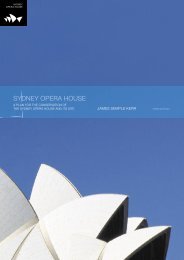nomination by the Government of Australia - Sydney Opera House
nomination by the Government of Australia - Sydney Opera House
nomination by the Government of Australia - Sydney Opera House
Create successful ePaper yourself
Turn your PDF publications into a flip-book with our unique Google optimized e-Paper software.
The sun did not know how beautiful its light was, until<br />
it was refl ected <strong>of</strong>f this building (Louis Kahn quoted in<br />
Utzon 2002: 18).<br />
2.A DESCRIPTION OF PROPERTY<br />
The <strong>Sydney</strong> <strong>Opera</strong> <strong>House</strong> is a masterpiece <strong>of</strong> late modern architecture and an iconic<br />
building <strong>of</strong> <strong>the</strong> 20th century. It is admired internationally and treasured <strong>by</strong> <strong>the</strong> people <strong>of</strong><br />
<strong>Australia</strong>. Created <strong>by</strong> an architect who had been an avid sailor and understood <strong>the</strong> sea,<br />
<strong>the</strong> <strong>Sydney</strong> <strong>Opera</strong> <strong>House</strong> inhabits <strong>the</strong> world-famous maritime location on <strong>Sydney</strong> Harbour<br />
with such grace that it appears that <strong>the</strong> building belongs <strong>the</strong>re naturally. The massive<br />
concrete sculptural shells that form <strong>the</strong> <strong>Sydney</strong> <strong>Opera</strong> <strong>House</strong>’s ro<strong>of</strong> appear like billowing<br />
sails fi lled <strong>by</strong> <strong>the</strong> sea winds with <strong>the</strong> sunlight and cloud shadows playing across <strong>the</strong>ir<br />
shining white surfaces. As its Danish architect Jørn Utzon envisaged, it is like a Gothic<br />
ca<strong>the</strong>dral that people will never tire <strong>of</strong> and ‘never be fi nished with’ (Utzon 1965a: 49).<br />
The <strong>Sydney</strong> <strong>Opera</strong> <strong>House</strong> represents a rare and outstanding architectural achievement:<br />
structural engineering that stretched <strong>the</strong> boundaries <strong>of</strong> <strong>the</strong> possible and sculptural<br />
architectural forms that raise <strong>the</strong> human spirit. It not only represents <strong>the</strong> masterwork<br />
<strong>of</strong> Utzon but also <strong>the</strong> exceptional collaborative achievements <strong>of</strong> engineers, building<br />
contractors and o<strong>the</strong>r architects. The <strong>Sydney</strong> <strong>Opera</strong> <strong>House</strong> is unique as a great building<br />
<strong>of</strong> <strong>the</strong> world that functions as a world-class performing arts centre, a great urban<br />
sculpture and a public venue for community activities and tourism. This monumental<br />
building has become a symbol <strong>of</strong> its city and <strong>the</strong> <strong>Australia</strong>n nation. The <strong>Sydney</strong> <strong>Opera</strong><br />
<strong>House</strong> ‘is not a simple entity… [but] alive with citizens and urbanity’ (Domicelj 2005).<br />
The outstanding natural beauty <strong>of</strong> <strong>the</strong> setting <strong>of</strong> <strong>the</strong> <strong>Sydney</strong> <strong>Opera</strong> <strong>House</strong> is intrinsic to<br />
its signifi cance. The <strong>Sydney</strong> <strong>Opera</strong> <strong>House</strong> is situated at <strong>the</strong> tip <strong>of</strong> a prominent peninsula<br />
projecting into <strong>Sydney</strong> Harbour (known as Bennelong Point) and within close proximity<br />
to <strong>the</strong> Royal Botanic Gardens and <strong>the</strong> world famous <strong>Sydney</strong> Harbour Bridge. Bennelong<br />
Point is fl anked <strong>by</strong> <strong>Sydney</strong> Cove, Farm Cove and Macquarie Street (Figures 2.2 and 2.3).<br />
These sites saw <strong>the</strong> fi rst settlement, farming and governing endeavours <strong>of</strong> <strong>the</strong> colony in<br />
<strong>the</strong> late 18th and early 19th centuries. Known as ‘Jubgalee’ <strong>by</strong> <strong>the</strong> traditional Aboriginal<br />
custodians (<strong>the</strong> Cadigal people), Bennelong Point was a meeting place <strong>of</strong> Aboriginal and<br />
European people during <strong>the</strong> early years <strong>of</strong> <strong>the</strong> colony.<br />
The <strong>Sydney</strong> <strong>Opera</strong> <strong>House</strong> is an exceptional building composition. Its architectural form<br />
comprises three groups <strong>of</strong> interlocking vaulted ‘shells’, set upon a vast terraced platform<br />
(‘<strong>the</strong> podium’) and surrounded <strong>by</strong> terrace areas that function as pedestrian concourses<br />
(see Figure 1.4). The shells are faced in glazed <strong>of</strong>f-white tiles while <strong>the</strong> podium is clad in<br />
earth-toned, reconstituted granite panels. The two main halls are arranged side <strong>by</strong> side,<br />
oriented north-south with <strong>the</strong>ir axes slightly inclined. The auditoria are carved out <strong>of</strong> <strong>the</strong><br />
high north end <strong>of</strong> <strong>the</strong> podium so that <strong>the</strong>y face south, towards <strong>the</strong> city, with <strong>the</strong> stage<br />
areas positioned between <strong>the</strong>m and <strong>the</strong> entrance foyers. The north and south ends <strong>of</strong><br />
<strong>the</strong> shells are hung with topaz glass walls that project diagonally outwards to form foyers,<br />
<strong>of</strong>fering views from inside and outside. The tallest shell reaches <strong>the</strong> height <strong>of</strong> a 20-storey<br />
building above <strong>the</strong> water. The shell structures cover nearly two hectares and <strong>the</strong> whole<br />
site is nearly six hectares (Figure 2.4).<br />
13

















